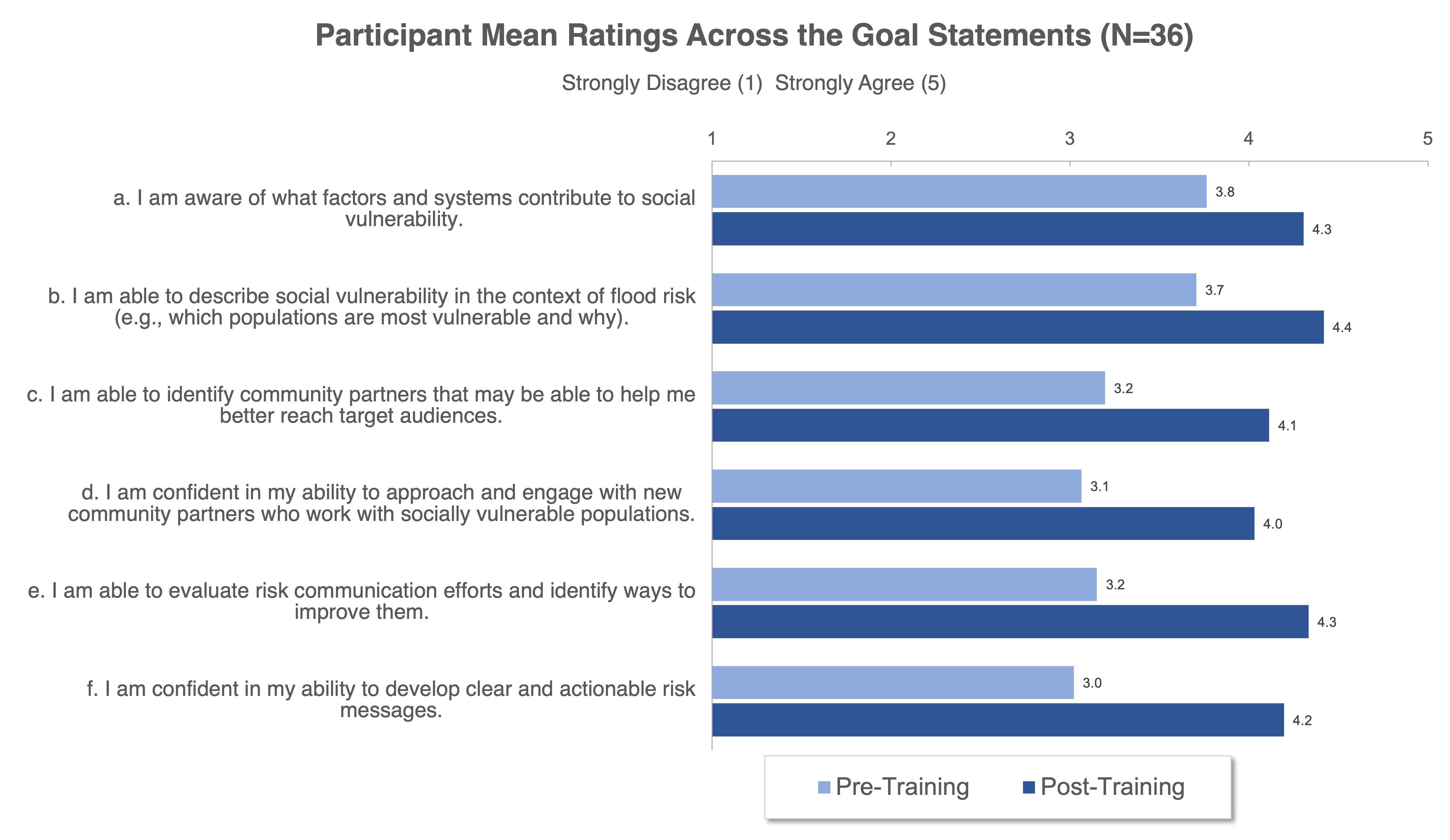Risk Communication and Social Vulnerability
Guidance for Practitioners
What is the Challenge?
For more than three decades, social scientists sought to understand how to best communicate information about hazard risk to diverse members of the public, building a substantial body of research literature around this topic. Yet, this research does not always reach practitioners, who could apply these lessons in their community engagement efforts. As a result, risk communication best practices are not always adopted. Additionally, socially vulnerable populations—those that face disproportionate disaster risk due to a variety of historical, social, economic, and political conditions—may not receive practical and actionable communications about disaster risk.
This project is designed to bridge this research to practice gap and to empower a new generation of risk communication leaders. The Natural Hazards Center research team partnered with the U.S. Army Corps of Engineers Institute for Water Resources to provide resources to accomplish this goal. In this multi-year partnership, the team synthesized the state of knowledge on risk communication, with a particular focus on the needs of the most vulnerable populations. Using this as the foundation, these resources help translate that understanding into practice. The deliverables for this project build on one another; each step is described below.
Project Steps and Deliverables

Step 1: Summarize Knowledge into an Annotated Bibliography
The annotated bibliography summarizes academic research and practical guidance on the topic of hazards and disaster risk communication, with a particular focus on socially vulnerable populations. It features a range of risk communication lessons that can be applied before, during, and after a hazard event.
Step 2: Synthesize Body of Knowledge into Three Key Principles
The practitioner-oriented guide synthesizes insights from the published literature into three overarching principles, including how general risk communication principles can be thoughtfully applied to groups that are often marginalized, overlooked, or difficult to reach. The key principles include:
- Communicate Through Familiar and Trusted Messengers;
- Provide Clear, Actionable Information; and
- Tailor Messages and Information Pathways for Target Audiences.
Step 3: Develop Worksheets to Apply the Key Principles in Practice
The worksheet booklet goes in depth into each of the core principles, with questions and considerations that guides users in applying the principles to their own work. The worksheets also include exercises for before and after implementing the core principles to help characterize the community and reflect on the risk communication process.
Step 4: Facilitate Practitioner Trainings in Risk Communication and Social Vulnerability
Practitioner trainings expand the foundational resources above by including interactive group activities and case studies to help participants apply these concepts in their respective contexts. The Natural Hazards Center team led two virtual 6-session courses and a 2-day intensive training with over 70 U.S. Army Corps personnel that led to the creation of additional resources, such as a glossary of key terms and a quick guide for risk communication. Pre- and post-training survey’s show improvement across goal areas.

“The Principles worksheets were very useful in providing helpful questions that gear the user to research further to identify effective strategies in risk communication, target audience characterization, and partner selection.” (Spring 2022 Virtual Training Participant)
“The training, materials, and insight I received during the training will allow me to better understand and communicate with [underserved] communities.” (Spring 2023 In-Person Training Participant)
“I will certainly pay more attention to details when determining how best to engage vulnerable populations. I will also make sure that we listen first to understand their needs before we start telling folks what we can and cannot do.” (Spring 2023 In-Person Training Participant)
“The Natural Hazards Center employees did an incredible job of relaying information generally about risk communication with socially vulnerable populations.” (Spring 2023 In-Person Training Participant)
Next Steps and Additional Resources
We are now working with our partners to consider how we can continue to share these resources and expand the trainings to maximize their impact.
Additional Resources:
- Glossary: Risk Communication and Social Vulnerability
- Selected Tips for Developing and Disseminating Risk Information
Related Webinars:
- Risk Communication and Social Vulnerability (Feb 2023)
- Exercises in Risk Communication: Serving the Whole Community with a Focus on Socially Vulnerable Populations (Sep 2021)
- Risk Communication and Social Vulnerability Across the Disaster Lifecycle: Resources for Practitioners (Sep 2020)
Project Team
Project Research Lead: Carson MacPherson-Krutsky, Natural Hazards Center (carson.m-k@colorado.edu). Former Lead: Nnenia Campbell, Natural Hazards Center (Nnenia.Campbell@colorado.edu)
Project Assistants: Luther Green and Mary Angelica Painter, Natural Hazards Center (Former Research Assistants: Evangelyne Eliason, Kamryn Roper-Fetter, and Mary Yoder, Natural Hazards Center)
Principal Investigator: Lori Peek, Natural Hazards Center and Department of Sociology, University of Colorado Boulder (Lori.Peek@colorado.edu)
U.S. Army Corps of Engineers: The National Flood Risk Management Team, the National Silver Jackets Program, and the Dam and Levee Safety Programs
Sponsor: This project is made possible with supplemental support from the U.S. Army Corps of Engineers Office of Homeland Security and the National Science Foundation (NSF Award #1635593).